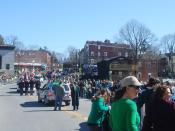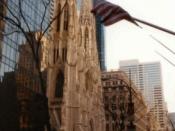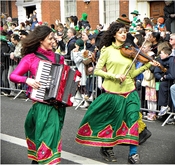For two hundred and forty years the Irish, whoever they may be, have been flaunting their ethnicity, a socially created system of rules about who does and does not belong to a particular group, and nationality through the St. Patrick's Day parade in New York City. Because so many immigrants came to the United States from Ireland and ended up finding good work and living conditions in New York, they stuck together. They lived in close proximity to one another, worked together, celebrated Irish holidays together, went to church together, ate with one another, etc. As the years went on this mini-Ireland grew to be bigger and bigger and there were places in NYC known for its Irish immigrants. Because of this ever-growing population, the Irish and Irish Americans, as Marston refers to them, began the St. Patrick's Day parade as a way to uphold their Irish identity and show the rest of America, the rest of the surrounding area of New York, that they weren't the stereotypical Irish that drank beer, were of the middle class, and were highly religious.
This may have been true for some Irish immigrants or descendents of immigrants, but it was not true for all.
As the parade grew in popularity, as well as in political, social, and cultural value, more and more groups that identified themselves as Irish wanted to become a part. One group in particular, the Irish Lesbian and Gay Organization, the ILGO. In order to march in the St. Patrick's Day parade, one must apply to the AOH, Ancient Order of Hibernians, and interview with a member of that group. The first year the ILGO applied they were denied because the AOH claimed they had gotten their application too late. The following year the ILGO applied they were denied...


